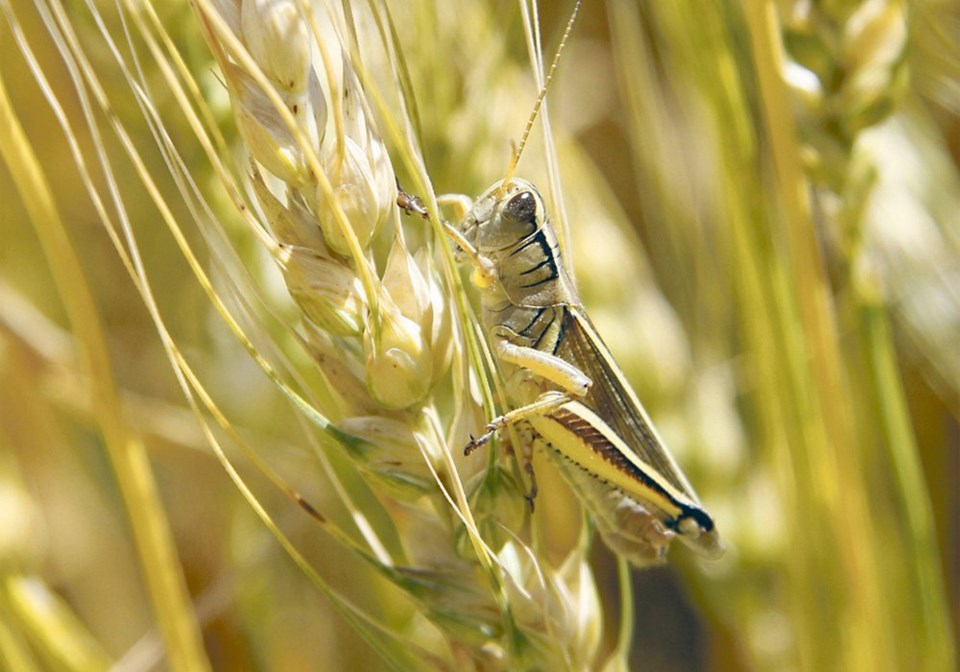WESTERN PRODUCER — Swarms of grasshoppers are chewing their way through prairie fields this harvest.
The plant-eating pests are also wreaking havoc with machinery and grain storage, testing the patience of farmers trying to get their crops in the bin.
“The ground is moving in front of the combine. They’re fluttering and going everywhere. It’s like a cloud of grasshoppers moving in front of the combine all the time,” said Myron Finlay of Vanguard, Sask.
“They stick to the augers and combine and grain cart. They make a thick gum coating on everything.”
Half-baked grasshopper juice also has a particularly abhorrent aroma that sticks to the nostrils.
“You know when they are on the front of your vehicle. That’s what it smells like. Like rotten socks,” he said.
The problem is so bad that it has become a daily chore to clean “the greasy guts of grasshoppers” from the combine hopper.
“Climbing into the combine hopper to get a sample of the lentils and you’re just covered with grasshoppers from head to toe.
“They’re pretty gross,” said Finlay. “We sprayed and we sprayed and it obviously helps but boy, there’s still a mess of grasshoppers out here.”
There are 85 kinds of grasshoppers in the province. Only four are typically pest species, but all four overwinter as eggs.
Populations are driven in large part by weather, said James Tansey, insect and pest management provincial specialist in Regina.
“What we’re seeing this year is really a product of what we saw last year coupled with some pretty good conditions for them this year. But there is a possibility for populations to be considerably higher than they are now.
“It had more to do with the dry conditions, but last year was a perfect storm for these animals to get eggs into the ground,” said Tansey.
Cool temperatures this spring slowed development and reduced populations in some areas, but were not broad enough throughout the Prairies.
“What it resulted in more was a delay in emergence and development of grasshopper nymphs. But some of these populations have come up in large numbers as of late,” Tansey said.
“Regionally, the situation is pretty dire. We do have a number of different areas that have experienced large increases in grasshopper populations relative to last year. Many of these have required multiple sprays. So, we do have some pretty significant pressures in the south-central and southwestern regions.”
The big issue for farmers now is to look at thresholds, including pre-harvest spraying intervals and potential issues with maximum residue limits for insecticides, which can affect crop sales.
“These animals will continue to eat beyond where crops are tolerant to other insects feeding. So, cereals well into dough can still be fed on by grasshoppers,” said Tansey.
He advised producers to use insecticides registered for their crop and for grasshoppers and be aware of the wait time between a pesticide application and when a crop can be harvested, as well as potential issues with residue.
Despite spraying insecticide multiple times, the grasshoppers are winning the battle this year, said Finlay.
“The threshold for spraying on lentils is so low. We sprayed lentils and flax and both are bad, but I had wheat where it started to look like a hailstorm had gone through it when we sprayed it. They (grasshoppers) snip it off below the head and it just tips over like it’s got hail.
“It’s all grasshopper damage and we got them bad in everything. I know a lot of guys have lost a lot of yield in their lentils because of the grasshoppers.”
He estimated about half his lentil yield has been squandered by grasshoppers.
“The wheat can take it a lot worse but we’ve got stuff that’s going to have some substantial yield loss; 10 percent probably pretty easy,” he said.
However, Finlay is most concerned with the moisture levels in his bins, particularly lentils that contain thousands of whole grasshoppers as well as bits and pieces of them.
“Our biggest issue is what are they going to do in the bin because they’re just really, really slimy. And when we combined them, the lentils are dry and the grasshoppers are a little juicy.
“We just keep moving them and rotated aeration fans are on them. It’s just like controlling a really tough crop, is the way we’re treating it.”
Grain terminals are expecting to see grasshoppers but it’s too early to determine severity.
“We haven’t seen a whole bunch of grain samples with many grasshoppers in it yet. But I’m hearing some guys are seeing a lot of it and it’ll go as dockage towards them,” said Ryan Keenleyside, farm marketing representative with South West Terminal in Kyle, Sask.
“Aeration will dry them down, which is good, but you can always get pockets in those bins that doesn’t move air. I don’t know how good the air flows through if there’s a bunch of grasshoppers because that’ll be a factor,” he said.
The consensus is that infestation is patchy and varies from one farm and area to the next.
“It’s not like a blanket of a whole bunch of grasshoppers, which is strange. Usually when you see them, they’re bad everywhere, but it’s kind of pockets here and there,” said Keenleyside.




